Lot details Distemper and gold on cloth. Mounted as a hanging scroll on a fine Chinese silk brocade frame dating from the Ming dynasty (1368-1644). The central palace houses the goddess Green Tara in union with the Cosmic Buddha Amoghasiddhi, seated above a white moon disk and lotus plinth. They are accompanied by a retinue of seventeen other Taras bearing the colors of the Five Buddha Families. The upper and lower registers with bodhisattvas, Lamas, and wrathful protectors. Superbly painted with meticulous attention to detail and skillfully orchestrated patterns of multi-colored flame and foliate scroll designs. Inscriptions: An inscription below the lower register of the composition identifies the two figures depicted in the corners: Lower left, ‘Homage to the Precious (Lama) Konchog Lhundrub (1497-1557), the 10th Abbot of Ngor monastery (in office 1534-1557)’. Lower right, ‘Hail to the religious teacher Choje Kunga Lhundrub (dates unknown)’. Further inscriptions in gold ink to the upper and lower registers identify several of the portrayed deities and Lamas, including the progenitor of the Seventeen Deity Tara Mandala, Ravigupta (c. 7th-8th century), second from left in the upper register, flanked by Green Tara and Chandragarbha (Atisha), the lower register with Kamaraja, Kurukulla, Ganapati, Yellow Jambhala, and Black Jambhala. The verso with the mantra ‘Om Ah Hum’ inscribed numerous times. Provenance: From the private collection of Norman Blount (1875-1930), and thence by descent in the same family. Norman Blount was a British merchant active in Calcutta as a jute broker and senior partner of the firm Sinclair Murray & Co. In Calcutta, he co-founded and served as a secretary of the Indian Society of Oriental Art. The Society met monthly and organized art exhibitions, taught students, and published high-quality reproductions and illustrated journals. Horatio Herbert Kitchener (Lord Kitchener) was the Society’s first President. Condition: Superb condition with expected old wear, some creasing, minor soiling, very little fading to colors, few loose threads, and tiny losses. The mounting with wear and traces of use, some tears, minor losses, loose threads, fading. Dimensions: Image size 50 x 37 cm, Size incl. frame 83 x 54 cm The circle surrounding the central figures encloses images of eight deities including the red Buddha Amitabha holding a flower in one hand and a gold bell in the other, to his right, consort Pandara Vasini, red, similar in appearance, holding a lotus-handled curved knife and skullcup. On the right, a deity in green, holding a vajra and ghanta. Below is Buddha Vairochana, white, holding a wheel to the heart and a bell at the side. At the left is the consort Vajradhatvishvari, white, similar in appearance, holding to the heart a wheel-handled curved knife and a skullcup. At the left is Buddha Ratnasambhava, yellow, holding a jewel and bell. Above is the consort Buddha-Locani, yellow, holding to the heart a jewel-handled curved knife and a white skullcup. Each is seated in the inner ring of pink lotus petals, surrounded by variously colored spheres of light creating the shape of an eight-petalled lotus encircled by a ring. Outside of the circle, within the square enclosure are four female attendant deities, yellow Mukunda, red Muraja, green Vamsha, and white Vina, all seated in a relaxed posture. Slightly further, at each palace door there is a guardian deity: the pig-faced Varamukha, dog-faced Shvanamukha, lion-faced Simhamukha, and horse-faced Hayamukha. The outer square enclosure is composed of colorful foliate bands representing the walls of the celestial palace. The levels of the roof symbolically rise above each of the 'T' shaped doors topped with Dharma wheels and two reclining deer, arched by elongated snouts of makara heads. The outer ring is, similarly, populated by various deities. This mandala belongs to the Sakya sect, coming from the sub-school of the Ngor tradition. Ngor monastery, founded in
Lot details Distemper and gold on cloth. Mounted as a hanging scroll on a fine Chinese silk brocade frame dating from the Ming dynasty (1368-1644). The central palace houses the goddess Green Tara in union with the Cosmic Buddha Amoghasiddhi, seated above a white moon disk and lotus plinth. They are accompanied by a retinue of seventeen other Taras bearing the colors of the Five Buddha Families. The upper and lower registers with bodhisattvas, Lamas, and wrathful protectors. Superbly painted with meticulous attention to detail and skillfully orchestrated patterns of multi-colored flame and foliate scroll designs. Inscriptions: An inscription below the lower register of the composition identifies the two figures depicted in the corners: Lower left, ‘Homage to the Precious (Lama) Konchog Lhundrub (1497-1557), the 10th Abbot of Ngor monastery (in office 1534-1557)’. Lower right, ‘Hail to the religious teacher Choje Kunga Lhundrub (dates unknown)’. Further inscriptions in gold ink to the upper and lower registers identify several of the portrayed deities and Lamas, including the progenitor of the Seventeen Deity Tara Mandala, Ravigupta (c. 7th-8th century), second from left in the upper register, flanked by Green Tara and Chandragarbha (Atisha), the lower register with Kamaraja, Kurukulla, Ganapati, Yellow Jambhala, and Black Jambhala. The verso with the mantra ‘Om Ah Hum’ inscribed numerous times. Provenance: From the private collection of Norman Blount (1875-1930), and thence by descent in the same family. Norman Blount was a British merchant active in Calcutta as a jute broker and senior partner of the firm Sinclair Murray & Co. In Calcutta, he co-founded and served as a secretary of the Indian Society of Oriental Art. The Society met monthly and organized art exhibitions, taught students, and published high-quality reproductions and illustrated journals. Horatio Herbert Kitchener (Lord Kitchener) was the Society’s first President. Condition: Superb condition with expected old wear, some creasing, minor soiling, very little fading to colors, few loose threads, and tiny losses. The mounting with wear and traces of use, some tears, minor losses, loose threads, fading. Dimensions: Image size 50 x 37 cm, Size incl. frame 83 x 54 cm The circle surrounding the central figures encloses images of eight deities including the red Buddha Amitabha holding a flower in one hand and a gold bell in the other, to his right, consort Pandara Vasini, red, similar in appearance, holding a lotus-handled curved knife and skullcup. On the right, a deity in green, holding a vajra and ghanta. Below is Buddha Vairochana, white, holding a wheel to the heart and a bell at the side. At the left is the consort Vajradhatvishvari, white, similar in appearance, holding to the heart a wheel-handled curved knife and a skullcup. At the left is Buddha Ratnasambhava, yellow, holding a jewel and bell. Above is the consort Buddha-Locani, yellow, holding to the heart a jewel-handled curved knife and a white skullcup. Each is seated in the inner ring of pink lotus petals, surrounded by variously colored spheres of light creating the shape of an eight-petalled lotus encircled by a ring. Outside of the circle, within the square enclosure are four female attendant deities, yellow Mukunda, red Muraja, green Vamsha, and white Vina, all seated in a relaxed posture. Slightly further, at each palace door there is a guardian deity: the pig-faced Varamukha, dog-faced Shvanamukha, lion-faced Simhamukha, and horse-faced Hayamukha. The outer square enclosure is composed of colorful foliate bands representing the walls of the celestial palace. The levels of the roof symbolically rise above each of the 'T' shaped doors topped with Dharma wheels and two reclining deer, arched by elongated snouts of makara heads. The outer ring is, similarly, populated by various deities. This mandala belongs to the Sakya sect, coming from the sub-school of the Ngor tradition. Ngor monastery, founded in
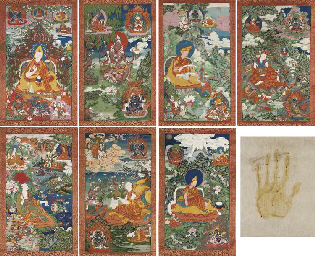
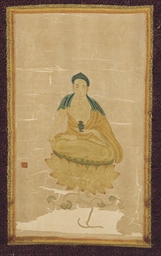
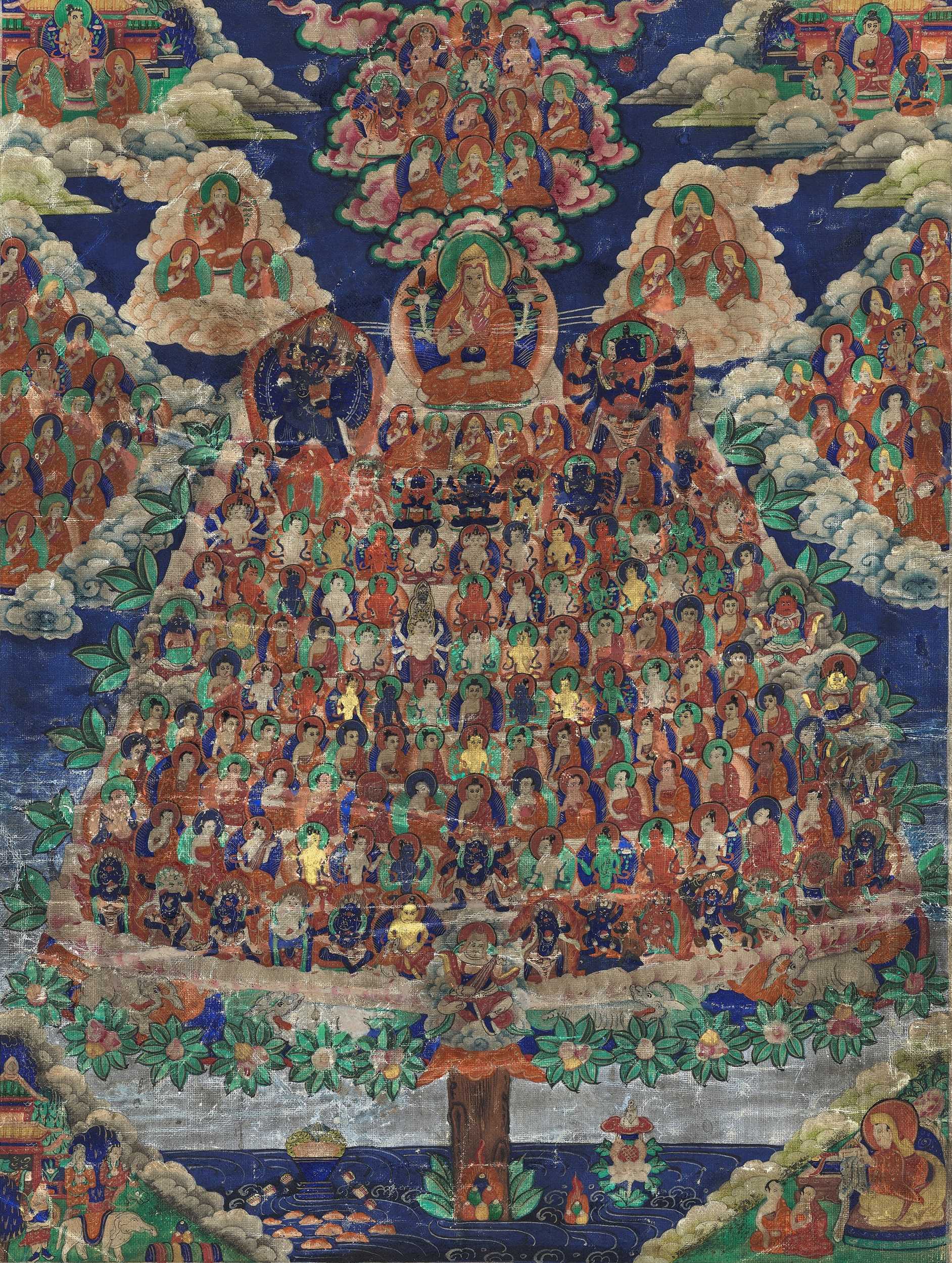



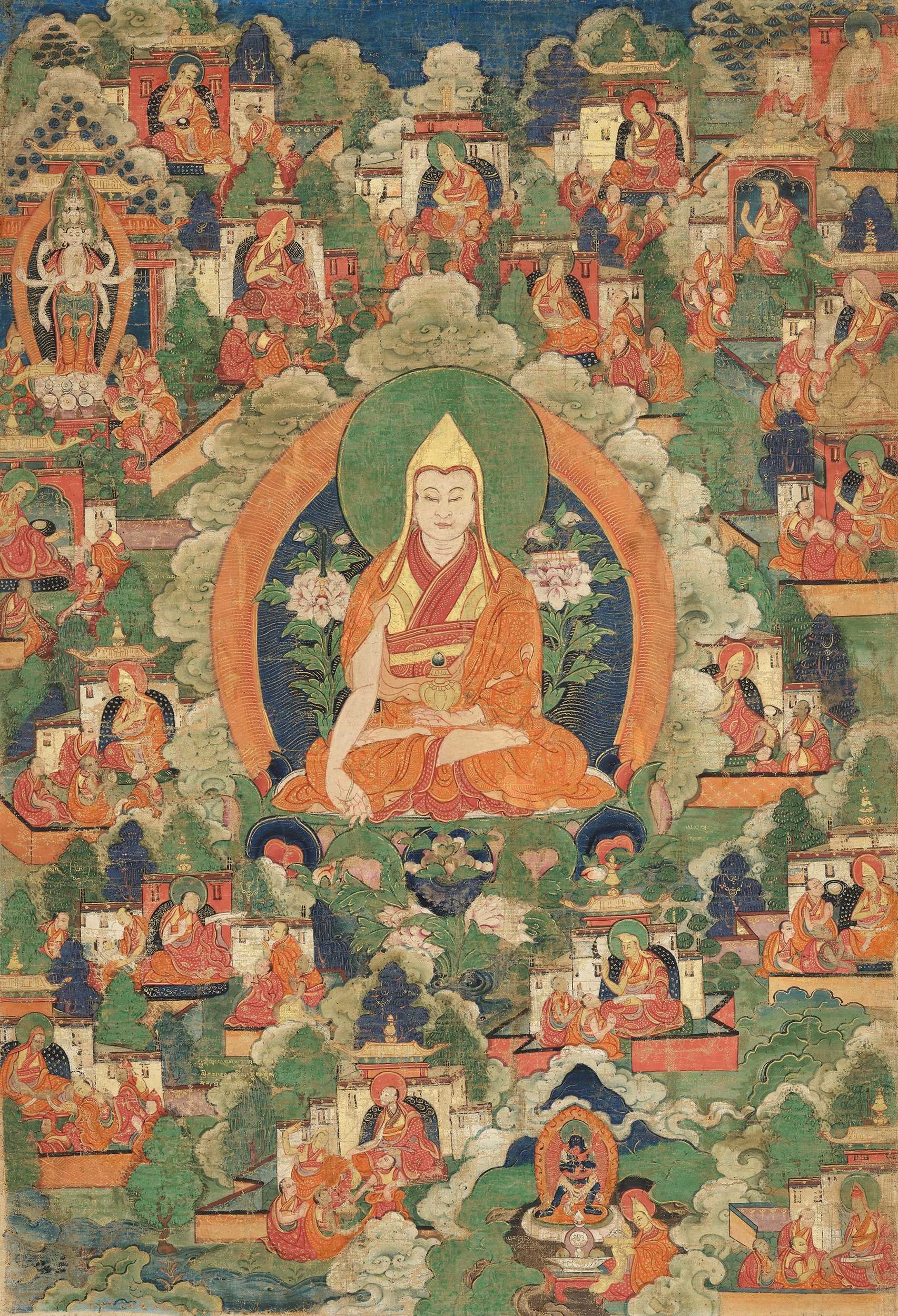
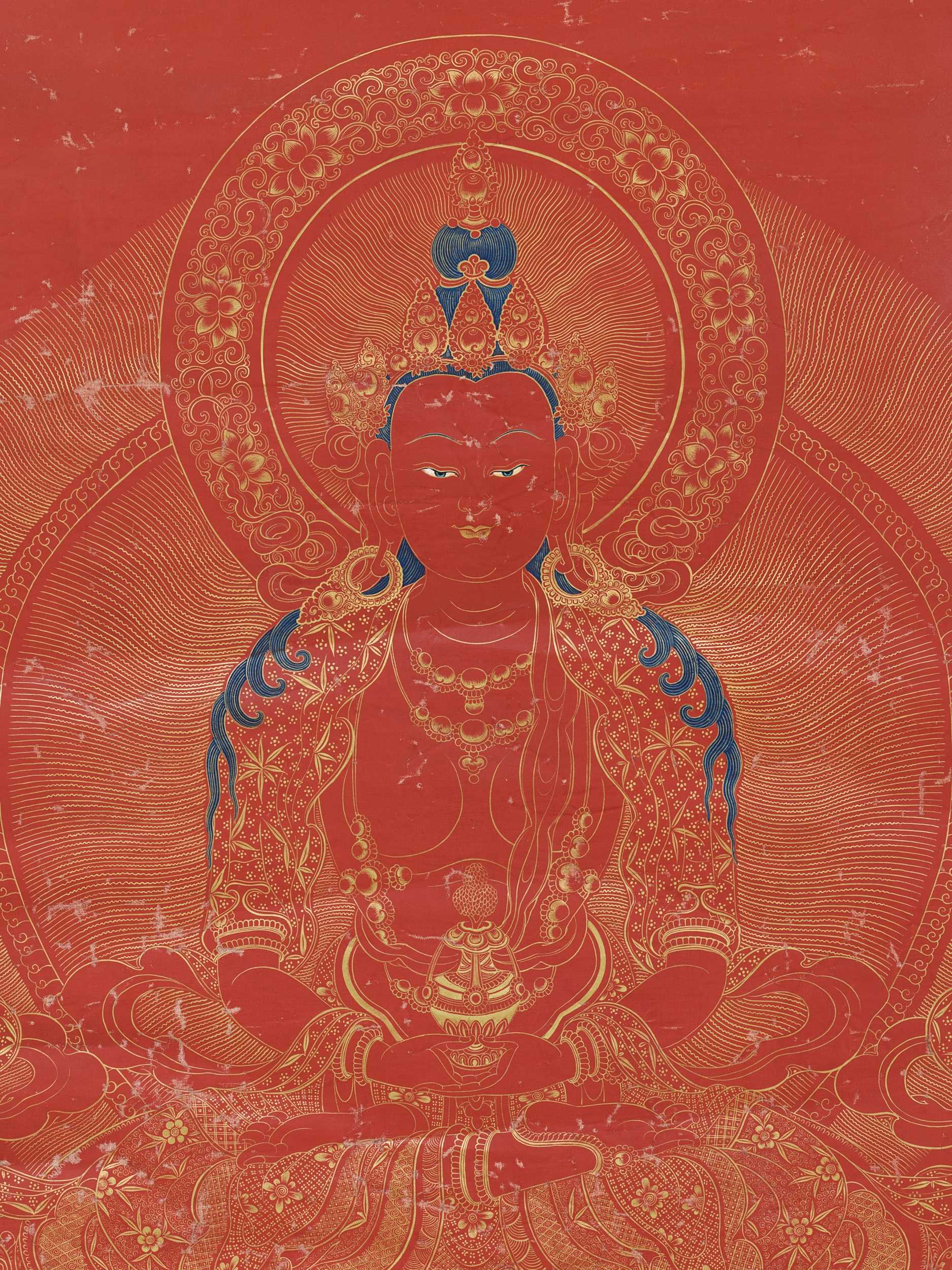
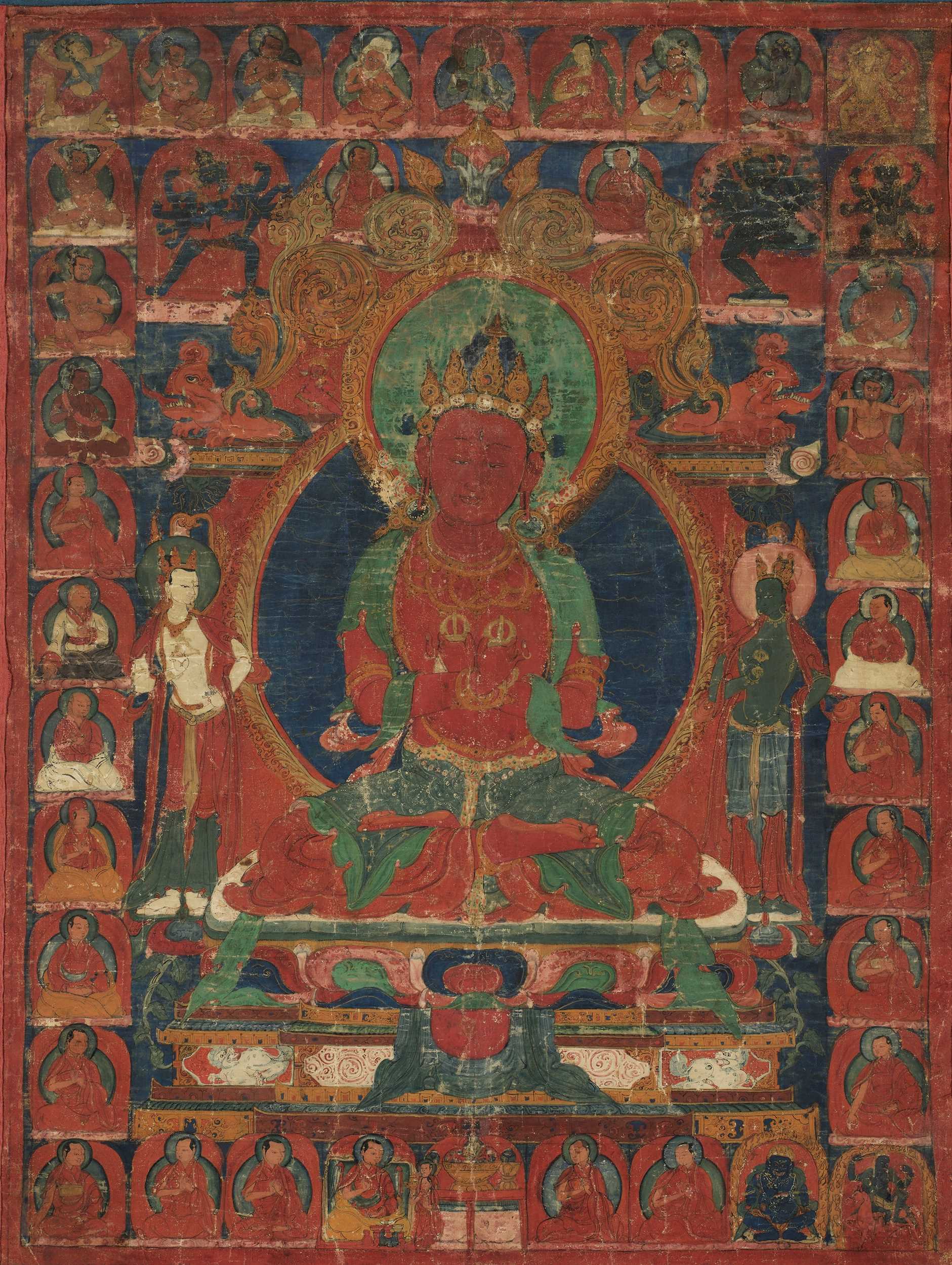
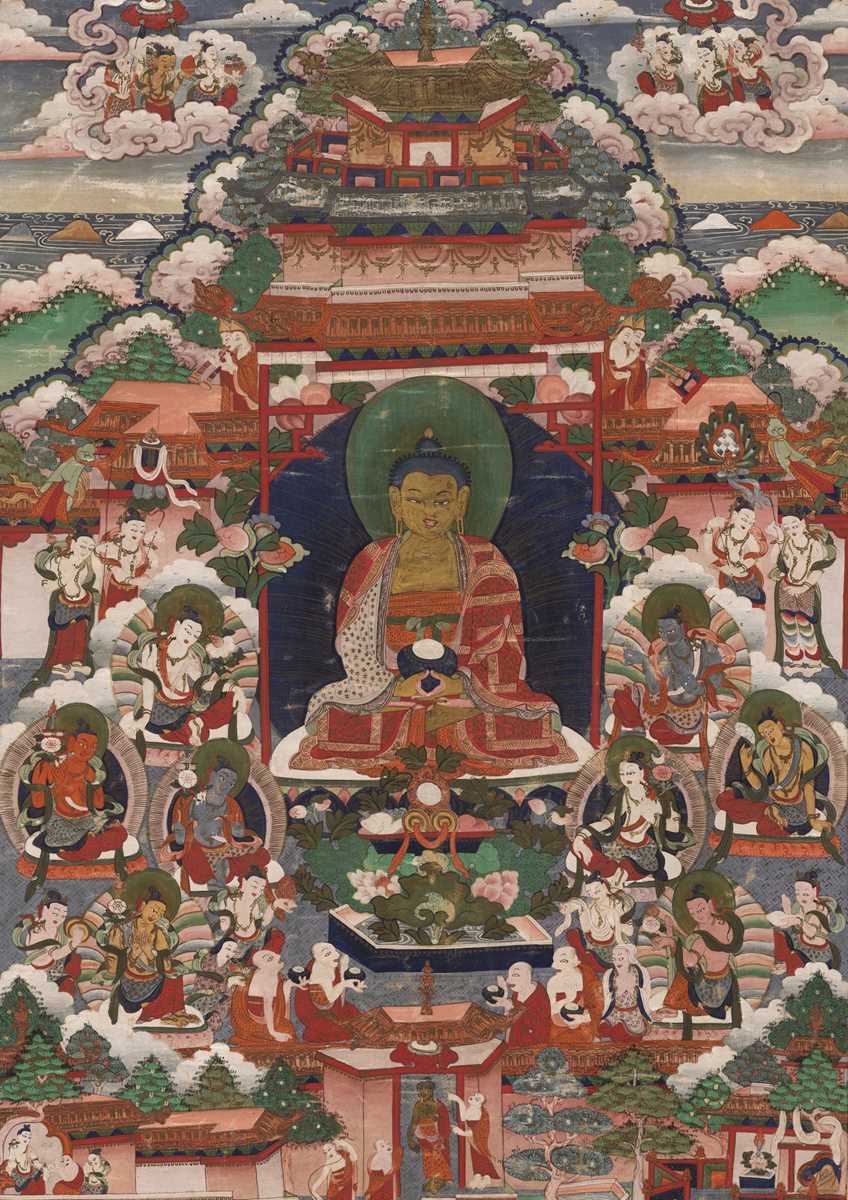

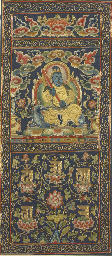

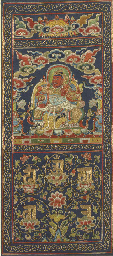
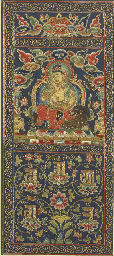
Try LotSearch and its premium features for 7 days - without any costs!
Be notified automatically about new items in upcoming auctions.
Create an alert